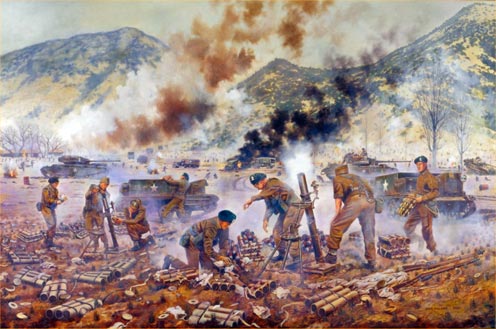
"Battle of the Imjin. Crash Action"
Ref: DR042
by David Rowlands
Image Size 58 x 38 cm
On 25th April 1951, Lieutenant John Mole, in command of the remaining section of The Royal Ulster Rifles 3-inch mortars, dismounted in the open and replied with rapid mortar fire on to the slopes from which a hail of machine-gun fire swept the valley floor.
The surviving tanks of C Squadron The 8th King's Royal Irish Hussars kept up a heavy fire on the Chinese formations swarming down the valley slopes. Two Centurion tanks, one blazing and one ditched, stood abandoned on the road. The jeep belonging to the CO of the Royal Northumberland Fusiliers was also on fire.
I met Brigadier Mervyn McCord and John Mole in the Reading Room of the National Army Museum and they explained to me the scene of the action. Mervyn pressed upon me the chaos and untidiness of the scene: "The more confusing you can make it the nearer you'll be to the truth." He lent me his valuable collection of photographs taken in Korea. Photographs which he took during a much later visit to the area show the nature of the dry paddy field and the surrounding hills. John provided me with a photo of himself taken on the day.
The badge of 29 Brigade is worn on the right shoulder of the battledress blouse, and on the left mudguard of the carriers. Some soldiers wear pullovers, and on the ground is a wind-proof smock. Most are wearing caubeens, and are equipped with 1944 pattern webbing and the Lee Enfield No.4 Mk1 rifle.
I also spoke to Albert Tyass who fought with the Battalion that day.
The mortar ammunition had been removed from its metal boxes and stacked in the two carriers ready for immediate use. Tony Debski, of The Ordnance Archive, gave me a great deal of advice on the mortar ammunition and the appearance of the discarded cardboard tubes, lids, etc. A mortar bomb was fired every fifteen seconds, and the litter around the position would accumulate rapidly. The scattered white bags protected the tail fins of the bombs.
